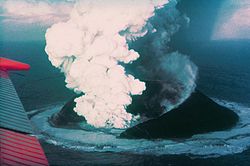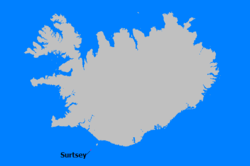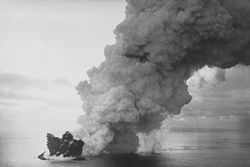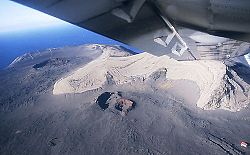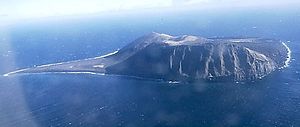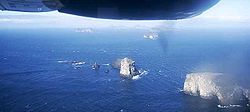
Surtsey
Background Information
SOS Children made this Wikipedia selection alongside other schools resources. Click here for more information on SOS Children.
Surtsey ( Icelandic: " Surtur's island") is a volcanic island off the southern coast of Iceland. At 63.4° N 20.3° W it is also the southernmost point of Iceland. It was formed in a volcanic eruption which began 130 metres below sea level, and reached the surface on 14 November 1963. The eruption may have started a few days earlier and lasted until 5 June 1967, when the island reached its maximum size of 2.7 km². Since then, wind and wave erosion has seen the island steadily diminish in size: As of 2007, its surface area is 1.4 km² in size.
The new island was named after the fire god Surtr from Norse mythology, and was intensively studied by volcanologists during its creation and, since the end of the eruption, has been of great interest to botanists and biologists as life has gradually colonised the originally barren island. The undersea vents that produced Surtsey are part of the Vestmannaeyjar (Westmann Isles) submarine volcanic system, part of the fissure of the sea floor called the Mid-Atlantic Ridge. Vestmannaeyjar also produced the famous eruption of Eldfell on the island of Heimaey in 1973. The eruption that created Surtsey also created a few other small islands along this volcanic chain, such as Jólnir and other unnamed peaks. Most of these eroded away fairly quickly.
Precursors to the eruption
At 07:15 UTC+0 on 14 November 1963, the cook of Ísleifur II, a trawler sailing off the Vestmannaeyjar archipelago south of Iceland, spotted something south-west of the boat, which turned out to be a rising column of dark smoke. The vessel went to investigate the smoke. The captain thought it might be a boat on fire, but instead they encountered explosive eruptions giving off black columns of ash, indicating that a volcanic eruption had begun beneath the sea.
Although the eruption was unexpected, there had been some indications before it began that volcanic activity was imminent. From 6 to 8 November, weak tremors were detected at Kirkjubaejarklaustur, from an epicentre measured to be 140 km distant (approximately the distance of Surtsey), while on 12 November, a seismograph in Reykjavík recorded weak tremors for ten hours, but their location was not determined. Two days before the eruption began, a marine research vessel noted that the sea in the area was somewhat warmer than normal , and at the same time, people in the coastal town of Vík on the mainland 80 km away had noticed a smell of hydrogen sulphide.
It is likely that the eruption had begun some days before 14 November. The sea floor is 130 metres below sea level, and at this depth explosive eruptions would be quenched by the water pressure. As the eruption built up a volcano approaching sea level, the explosions could no longer be quenched, and activity broke the surface.
Early days
By 11:00 on 14 November 1963, the eruption column had reached several kilometres in height. At first the eruptions took place at three separate vents along a north-east by south-west trending fissure, but by the afternoon the separate eruption columns had merged into one along the erupting fissure. Over the next week, explosions were continuous, and after just a few days the new island, formed mainly of scoria, measured over 500 metres in length and had reached a height of 45 metres.
The new island was named after the fire giant Surtr from Norse mythology. As the eruptions continued, they became concentrated at one vent along the fissure and began to build the island into a more circular shape. By 24 November, the island measured about 900 metres by 650 metres. The violent explosions caused by the meeting of lava and sea water meant that the island consisted of a loose pile of volcanic rock ( scoria), which was eroded rapidly by north Atlantic storms during the winter. However, eruptions more than kept pace with wave erosion, and by February 1964, the island had a maximum diameter of over 1300 metres.
One interesting event early in the island's life was the landing of three French journalists representing the magazine Paris Match on 6 December 1963. They stayed for about 15 minutes before violent explosions encouraged them to leave. The journalists jokingly claimed French sovereignty over the island, but Iceland quickly asserted that the new island belonged to it, having appeared in Icelandic territorial waters. Ferdinandea, near Sicily, is another island created by volcanic eruptions which has been subject to disputes over sovereignty.
Permanent island
The explosive phreatomagmatic eruptions caused by the easy access of water to the erupting vents threw rocks up to a kilometre away from the island, and sent ash clouds as high as 10 km up into the atmosphere. The loose pile of unconsolidated tephra would quickly have been washed away had the supply of fresh magma dwindled, and large clouds of dust were often seen blowing away from the island during this stage of the eruption.
By early 1964, though, the continuing eruptions had built the island to such a size that sea water could no longer easily reach the vents, and the volcanic activity became much less explosive. Instead, lava fountains and flows became the main form of activity. These resulted in a hard cap of extremely erosion-resistant rock being laid down on top of much of the loose volcanic pile, which prevented the island being washed away rapidly. Effusive eruptions continued until 1965, by which time the island had a surface area of 2.5 km².
28 December 1963 saw the onset of submarine activity 2.5 km to the north-east of Surtsey, which formed a ridge 100 m high on the sea floor. This seamount was named Surtla, but never reached sea level. Eruptions at Surtla ended on 6 January 1964, and it has since been eroded from its minimum depth of 23 m to 47 m below sea level.
Eruption gradually dies down
In 1965 the activity on the main island diminished, but at the end of May that year an eruption began at a vent 0.6 km off the northern shore. By 28 May an island had appeared, and was named Syrtlingur (Little Surtsey). The new island was washed away during early June, but reappeared on 14 June. Eruptions at Syrtlingur were much smaller in scale than those that had built Surtsey, with the average rate of emission of volcanic materials being about a tenth of the rate at the main vent. Activity was short-lived, continuing until the beginning of October 1965, by which time the islet had an area of 0.15 km². Once the eruptions had ceased, wave erosion rapidly wore the island away, and it disappeared beneath the waves on 24 October.
During December 1965, more submarine activity occurred 0.9 km south-west of Surtsey, and another island was formed. It was named Jólnir (Christmas Island), and over the following eight months it appeared and disappeared several times, as wave erosion and volcanic activity alternated in dominance. Activity at Jólnir was much weaker than the activity at the main vent, and even weaker than that seen at Syrtlingur, but the island eventually grew to a maximum size of 70 m in height, covering an area of 0.3 km², during July and early August 1966. Like Syrtlingur, though, after activity ceased on 8 August 1966, it was rapidly eroded, and dropped below sea level during October 1966.
19 August 1966 saw the return of effusive eruptions on the main island, with fresh lava flows giving it further resistance to erosion. The eruption rate diminished steadily, though, and on 5 June 1967, the eruption ended. The volcano has been dormant ever since. The total volume of lava emitted during the three-and-a-half-year eruption was about one cubic kilometre, and the island's highest point was 174 metres above sea level.
Since the end of the eruption, erosion has seen the island diminish in size. A large area on the south-east side has been eroded away completely, while a sand spit called Norðurtangi (north point) has grown on the north side of the island. It is estimated that about 0.024 km³ of material has been lost due to erosion – this represents about a quarter of the original above sea level volume of the island.
Settlement of life
A classic site for the study of biocolonisation from founder populations that arrive from outside ( allochthonous), Surtsey was declared a nature reserve in 1965 while the eruption was still in active progress. Today only a small number of scientists are permitted to land on Surtsey; the only way anyone else can see it closely is with a small plane. This allows the natural ecological succession for the island to proceed without outside interference. In 2001, the Icelandic government submitted the island to be listed as a UNESCO World Heritage Site, in recognition of its great scientific value.
Plant life
In the summer of 1965 the first vascular plant was found growing on Surtsey, mosses became visible in 1968 and lichens were first found on the Surtsey lava in 1970. Plant colonization on Surtsey has been closely studied, the vascular plants in particular as they have been of far greater significance than mosses and lichens in the vegetation development.
Mosses and lichens now cover much of the island. During the island's first 20 years, 20 species of plants were observed at one time or another, but only 10 became established in the nutrient-poor sandy soil. As birds began nesting on the island, soil conditions improved, and more advanced species of plants were able to survive. In 1998, the first bush was found on the island – a tea-leaved willow ( Salix phylicifolia), which can grow to heights of up to 4 metres. In total at least 60 species of plant have been found on Surtsey, of which about 30 have become established. More species continue to arrive, at a typical rate of roughly 2–5 new species per year. In July 2007, five species of plants were found for the first time.
Birds
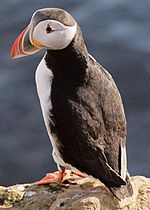
The expansion of bird life on the island has both relied on and helped to advance the spread of plant life. Birds use plants for nesting material, but also assist in the spreading of seeds, and fertilize the soil with their guano. Birds began nesting on Surtsey three years after the eruptions ended, with fulmar and guillemot the first species to set up home. Eight species are now regularly found on the island.
A gull colony has been present since 1986, although gulls were seen briefly on the shores of the new island only weeks after it first appeared. The gull colony has been particularly important in developing the plant life on Surtsey, and the gulls have had much more of an impact on plant colonisation than other breeding species due to their abundance. An expedition in 2004 found the first evidence of Atlantic Puffins nesting on the island. Puffins are extremely common in the rest of the archipelago.
As well as providing a home for some species of birds, Surtsey has also been used as a stopping-off point for migrating birds, particularly those en route between the British Isles and Iceland. Species that have been seen briefly on the island include whooper swans, various species of goose, and ravens. Although Surtsey lies to the east of the main migration routes to Iceland, it has become a more common stopping point as its vegetation has improved.
Marine life
Soon after the island's formation, seals were seen around the island. They soon began basking there, particularly on the northern spit, which grew as the waves eroded the island. Seals were found to be breeding on the island in 1983, and a group of up to 70 made the island their breeding spot. Grey seals are more common on the island than common seals, but both are now well established. The presence of seals attracts killer whales, which are frequently seen in the waters around the Vestmannaeyjar archipelago and now frequent the waters around Surtsey.
On the submarine portion of the island, many marine species are found. Starfish are abundant, as are sea urchins and limpets. The rocks are covered in algae, and seaweed covers much of the submarine slopes of the volcano, with its densest cover between 10 and 20 metres below sea level.
Other life
Insects arrived on Surtsey soon after its formation, and were first detected in 1964. The original arrivals were flying insects, carried to the island by winds and their own power. Some were believed to have been blown across from as far away as Mainland Europe. Later insect life arrived on floating driftwood, and both live animals and corpses washed up on the island. When a large, grass-covered tussock was washed ashore in 1974, scientists took half of it for analysis and discovered 663 land invertebrates, mostly mites and springtails, the great majority of which had survived the crossing.
The establishment of insect life provided some food for birds, and birds in turn helped many species to become established on the island. The bodies of dead birds provide sustenance for carnivorous insects, while the fertilisation of the soil and resulting promotion of plant life provides a viable habitat for herbivorous insects.
Some higher forms of land life are now colonising the soil of Surtsey. The first earthworm was found in a soil sample in 1993, probably carried over from Heimaey by a bird. Slugs were found in 1998, and appeared to be similar to varieties found in the southern Icelandic mainland. Spiders and beetles have also become established.
Future
Following the end of the eruption, scientists established a grid of benchmarks against which they measured the change in the shape of the island. In the 20 years following the end of the eruption, measurements revealed that the island was steadily slumping vertically and had lost about a metre in height. The rate of slumping was initially about 20 cm per year but slowed to 1–2 cm a year by the 1990s. It had several causes: settling of the loose tephra forming the bulk of the volcano, compaction of sea floor sediments underlying the island, and downward warping of the lithosphere due to the weight of the volcano.
The typical pattern of volcanism in the Vestmannaeyjar archipelago is for each eruption site to see just a single eruption, and so the island is unlikely to be enlarged in the future by further eruptions. The heavy seas around the island have been eroding it ever since the island appeared, and since the end of the eruption almost half its original area has been lost. The island currently loses about 10,000 square metres of its surface area each year.
However, the island is unlikely to disappear entirely in the near future. The eroded area consisted mostly of loose tephra, easily washed away by wind and waves. Most of the remaining area is capped by hard lava flows, which are much more resistant to erosion. In addition, complex chemical reactions within the loose tephra within the island have gradually formed highly erosion resistant tuff material, in a process known as palagonitization. On Surtsey this process has happened quite rapidly, due to high temperatures not far below the surface.
Estimates of how long Surtsey will survive are based on the rate of erosion seen up to the present day. Assuming that the current rate does not change, the island will be mostly at or below sea level by 2100. However, the rate of erosion is likely to slow as the tougher core of the island is exposed. A more optimistic assessment assuming that the rate of erosion will slow exponentially suggests that the island will survive for many centuries. An idea of what it will look like in the future is given by the other small islands in the Vestmannaeyjar archipelago, which formed in the same way as Surtsey several thousand years ago, and have eroded away substantially since they were formed.
